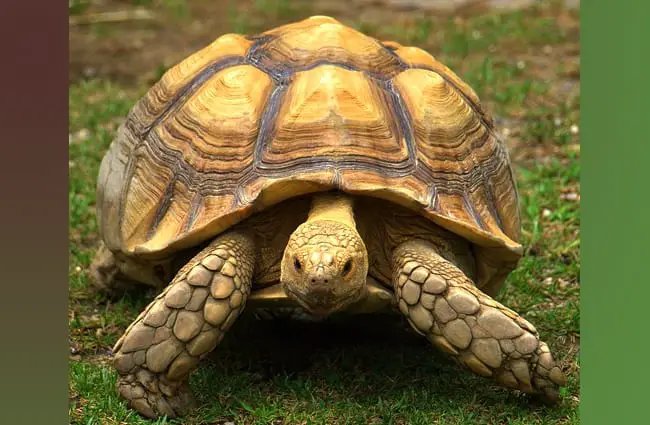
Think of it like choosing between a cozy apartment and a spacious backyard. Both options have their perks, but understanding what’s best for your tortoise involves knowing their needs. Let’s dive deeper together into the pros and cons of indoor versus outdoor living for Sulcata tortoises, and see which might be the right fit for you and your shelled friend.
Understanding the Sulcata Tortoise’s Natural Habitat
Sulcata tortoises, also called African spurred tortoises, hail from the arid regions of Africa. In their natural habitat, they roam vast expanses of dry grasslands and scrublands. They thrive in warm, sunny environments. So when thinking about whether to keep a Sulcata indoors or outdoors, it’s crucial to consider their primal instincts and habitat requirements.
These tortoises need a lot of space to explore and graze. It’s important to replicate this environment as closely as possible. If you can, try to mimic their natural surroundings, including providing adequate heat and access to sunlight. Outdoor living can offer them the exercise and stimulation they need to stay healthy and happy.
The Benefits of Outdoor Living for Sulcata Tortoises
Let’s be honest: when it comes to space and freedom, outdoor living is hard to beat. Here are some of the top benefits:
- Room to roam: An outdoor enclosure allows Sulcata tortoises to walk freely and explore their surroundings.
- Natural sunlight: Exposure to the sun is essential for their health. It helps them synthesize vitamin D and keeps their shell strong.
- Natural diet: In an outdoor setting, your tortoise can have access to fresh grasses and weeds that are safe for them to eat.
However, before you set up a lovely outdoor habitat, consider a few factors. Weather changes can affect their health, and you’ll need to ensure they have a secure area to protect them from predators. Also, think about temperature: extreme heat or cold can be dangerous for them.
Challenges of Keeping Sulcata Tortoises Outdoors
While outdoor living holds lots of advantages, it’s not all sunshine and rainbows. There are certain challenges to keep in mind:
- Predators: Depending on where you live, your tortoise could be at risk from animals like dogs, raccoons, or even birds of prey.
- Extreme weather: Sudden temperature drops or scorching heat can be harmful. You’ll need to provide shelter and shade for protection.
- Digging habits: Sulcata tortoises love to dig! They might escape from their enclosure if not set up properly.
It’s essential to consider how to properly design an outdoor space that keeps them safe and healthy. A well-fenced area with a secure roof could be a great solution to keep them protected.
The Case for Indoor Living with Sulcata Tortoises
For those who might be worried about predators or unpredictable weather, keeping a Sulcata tortoise indoors might be the way to go. Let’s look at some advantages:
- Controlled environment: You can easily maintain the right temperature and humidity indoors, ensuring your tortoise’s health.
- Safety from predators: Indoor living means your tortoise is safe from outside dangers and escape attempts.
- Convenience: Having them indoors makes it easier to monitor their health and behavior.
However, while an indoor habitat can be beneficial, you’ll need to put in some work to ensure your tortoise thrives. This might mean building a spacious enclosure that mimics their natural habitat, using UVB lighting, and providing a varied diet.
What Indoor Enclosures Should Look Like
Creating an indoor environment for a Sulcata tortoise can be a rewarding project. Here’s what to keep in mind:
1. Space: They need ample room to roam, so consider using a large tortoise table or even a dedicated room.
2. Heating and Lighting: You’ll need to provide a heat source, like a basking lamp, and a UVB light to mimic sunlight.
3. Substrate: Use materials like coconut coir or aspen shavings to help maintain humidity and allow for digging.
Don’t forget to include hiding spots and areas for exploration. Plants can also make great additions to the indoor habitat—just be sure they’re safe for tortoises!
Socialization and Interaction
Whether your Sulcata tortoise is indoors or outdoors, they need social interaction. Surprisingly, they can develop bonds with their owners. Spending time with them can help keep them accustomed to human presence, which is especially crucial if you’re keeping them indoors.
You might be wondering, “Can I take my tortoise outside for a bit of sun?” Absolutely! A supervised outdoor session can provide the best of both worlds, allowing them to soak up some rays while also enjoying fresh air. Just be sure to keep an eye on them.
Final Thoughts: Which Is Right for Your Sulcata Tortoise?
In the end, the choice between indoor and outdoor living depends on your personal circumstances and your tortoise’s well-being. If you have the space and can provide a safe outdoor habitat with the correct environmental conditions, it might be a fantastic option.
On the other hand, if you live in a place with harsh weather or predators, an indoor environment may be better suited. The key is to provide a loving, safe, and stimulating environment that meets all your tortoise’s needs.
Whatever path you choose, remember that your Sulcata tortoise will depend on you for their care and happiness. With the right setup and a little TLC, you’ll both enjoy many happy years together, whether indoors or out!

